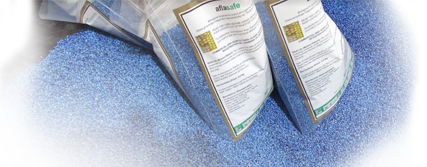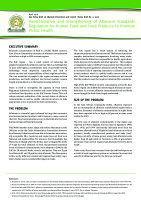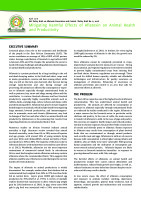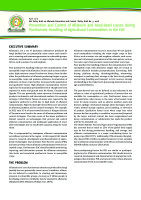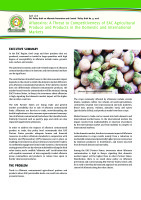Warning: Undefined variable $typesql in /home/aflasafe/public_html/wp-content/themes/aflasafe/functions.php on line 995
This series of policy briefs, prepared in 2017, examines the evidence on a range of topics relating to the harmful effects of aflatoxin, and provides policy options to address these within the East African Community.
Aflatoxin is highly toxic to humans and causes liver cancer, slowed growth in children, weakens the body immune system to fight diseases and exacerbates infectious diseases such as hepatitis, human immunodeficiency virus (HIV) syndrome and tuberculosis...
The most vulnerable group of population is exposed to Aflatoxins within 1000 days of life from conception to the child’s second birthday. This population group is highly affected because their body systems have not fully developed to allow for detoxification...
Aflatoxin contamination in food is a Public Health concern. East African Community (EAC) estimates of aflatoxin contamination in food are as high as 60% in some regions...
Liver cancer is a leading cause of deaths in the world. Chronic hepatitis B infection causes 80 percent of liver cancer cases in the EAC region. The combination of aflatoxin exposure with hepatitis infection...
Aflatoxins are poisonous substance produced by fungus that grows and contaminates most of staple food including cereals, oils seeds, roots crops and legumes. Aflatoxin contaminates a quarter of the world’s food supply...
Livestock plays a key role in the economies and livelihoods of the people in the East African Community (EAC).The sector contributes an average of 10% of GDP of EAC Partner States. Average contribution of livestock to agricultural GDP is between 30% and 15%...
Poor postharvest handling enhances the contamination of the susceptible crops with aflatoxins. Factors such as insect infestation, high moisture causes post-harvest losses, these further allow the proliferation of aflatoxin producing fungus...
Agricultural commodities, including maize, groundnuts, cassava, milk, and cottonseed contaminated with aflatoxin pose serious threats to human and animal health, and to the economies of the EAC Partner States...
In the EAC Region, food crops and their products that are produced, consumed or traded in large quantities with high degree of susceptibility to aflatoxin include maize, groundnuts, cashew, and sesame. The potential economic and trade-related impacts of aflatoxin contaminated products in domestic and international markets...

